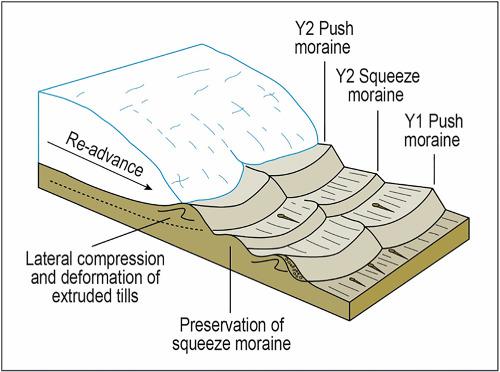当前位置:
X-MOL 学术
›
Earth Surf.Process. Land.
›
论文详情
Our official English website, www.x-mol.net, welcomes your feedback! (Note: you will need to create a separate account there.)
Sub‐annual moraine formation at an active temperate Icelandic glacier
Earth Surface Processes and Landforms ( IF 3.3 ) Pub Date : 2020-03-03 , DOI: 10.1002/esp.4835 Benjamin M.P. Chandler 1, 2 , Samuel J.P. Chandler 1 , David J.A. Evans 3 , Marek W. Ewertowski 4 , Harold Lovell 1 , David H. Roberts 3 , Martin Schaefer 1 , Aleksandra M. Tomczyk 4
Earth Surface Processes and Landforms ( IF 3.3 ) Pub Date : 2020-03-03 , DOI: 10.1002/esp.4835 Benjamin M.P. Chandler 1, 2 , Samuel J.P. Chandler 1 , David J.A. Evans 3 , Marek W. Ewertowski 4 , Harold Lovell 1 , David H. Roberts 3 , Martin Schaefer 1 , Aleksandra M. Tomczyk 4
Affiliation

|
This paper presents detailed geomorphological and sedimentological investigations of small recessional moraines at Fjallsjokull, an active temperate outlet of Oraefajokull, southeast Iceland. The moraines are characterised by striking sawtooth or hairpin planforms, which are locally superimposed, giving rise to a complex spatial pattern. We recognise two distinct populations of moraines, namely a group of relatively prominent moraine ridges (mean height ~1.2 m) and a group of comparatively low‐relief moraines (mean height ~0.4 m). These two groups often occur in sets/systems, comprising one pronounced outer ridge and several inset smaller moraines. Using a representative subsample of the moraines, we establish that they form by either (i) submarginal deformation and squeezing of subglacial till or (ii) pushing of extruded tills. Locally, proglacial (glaciofluvial) sediments are also incorporated within the moraines during pushing. For the first time, to our knowledge, we demonstrate categorically that these moraines formed sub‐annually using repeat uncrewed aerial vehicle (UAV) imagery. We present a conceptual model for sub‐annual moraine formation at Fjallsjokull that proposes the sawtooth moraine sequence comprises (i) sets of small squeeze moraines formed during melt‐driven squeeze events and (ii) larger push moraines formed during winter re‐advances. We suggest the development of this process‐form regime is linked to a combination of elevated temperatures, high surface meltwater fluxes to the bed, and emerging basal topography (a depositional overdeepening). These factors result in highly saturated subglacial sediments and high porewater pressures, which induces submarginal deformation and ice‐marginal squeezing during the melt season. Strong glacier recession during the summer, driven by elevated temperatures, allows several squeeze moraines to be emplaced. This process‐form regime may be characteristic of active temperate glaciers receding into overdeepenings during phases of elevated temperatures, especially where their englacial drainage systems allow efficient transfer of surface meltwater to the glacier bed near the snout margin.
中文翻译:

活跃的温带冰岛冰川的次年冰碛形成
本文详细介绍了 Fjallsjokull(冰岛东南部 Oraefajokull 的活动温带出口)的小型衰退冰碛的详细地貌和沉积学调查。冰碛以醒目的锯齿状或发夹状平面为特征,局部叠加,形成复杂的空间格局。我们识别出两种不同的冰碛种群,即一组相对突出的冰碛脊(平均高度约 1.2 m)和一组相对低起伏的冰碛(平均高度约 0.4 m)。这两组经常出现在集合/系统中,包括一个明显的外脊和几个插入的较小的冰碛。使用具有代表性的冰碛子样本,我们确定它们是通过 (i) 次边缘变形和冰下冰块挤压或 (ii) 挤压挤压形成的。在当地,在推进过程中,冰碛(冰川)沉积物也被纳入冰碛中。据我们所知,我们第一次使用重复的无人驾驶飞行器 (UAV) 图像明确地证明这些冰碛每年都会形成。我们提出了 Fjallsjokull 次年冰碛形成的概念模型,该模型提出锯齿状冰碛序列包括(i)在熔体驱动挤压事件期间形成的小挤压冰碛组和(ii)在冬季再推进期间形成的较大推力冰碛。我们认为,这种过程形式机制的发展与高温、高地表融水流向床层以及新出现的基底地形(沉积过度加深)的组合有关。这些因素导致高度饱和的冰下沉积物和高孔隙水压力,在融化季节引起次边缘变形和冰边缘挤压。夏季,由于气温升高,冰川严重衰退,使得几个挤压冰碛出现。这种过程形式可能是活动温带冰川在温度升高阶段退入过度加深的特征,特别是在它们的冰川排水系统允许地表融水有效转移到口缘附近的冰川床的情况下。
更新日期:2020-03-03
中文翻译:

活跃的温带冰岛冰川的次年冰碛形成
本文详细介绍了 Fjallsjokull(冰岛东南部 Oraefajokull 的活动温带出口)的小型衰退冰碛的详细地貌和沉积学调查。冰碛以醒目的锯齿状或发夹状平面为特征,局部叠加,形成复杂的空间格局。我们识别出两种不同的冰碛种群,即一组相对突出的冰碛脊(平均高度约 1.2 m)和一组相对低起伏的冰碛(平均高度约 0.4 m)。这两组经常出现在集合/系统中,包括一个明显的外脊和几个插入的较小的冰碛。使用具有代表性的冰碛子样本,我们确定它们是通过 (i) 次边缘变形和冰下冰块挤压或 (ii) 挤压挤压形成的。在当地,在推进过程中,冰碛(冰川)沉积物也被纳入冰碛中。据我们所知,我们第一次使用重复的无人驾驶飞行器 (UAV) 图像明确地证明这些冰碛每年都会形成。我们提出了 Fjallsjokull 次年冰碛形成的概念模型,该模型提出锯齿状冰碛序列包括(i)在熔体驱动挤压事件期间形成的小挤压冰碛组和(ii)在冬季再推进期间形成的较大推力冰碛。我们认为,这种过程形式机制的发展与高温、高地表融水流向床层以及新出现的基底地形(沉积过度加深)的组合有关。这些因素导致高度饱和的冰下沉积物和高孔隙水压力,在融化季节引起次边缘变形和冰边缘挤压。夏季,由于气温升高,冰川严重衰退,使得几个挤压冰碛出现。这种过程形式可能是活动温带冰川在温度升高阶段退入过度加深的特征,特别是在它们的冰川排水系统允许地表融水有效转移到口缘附近的冰川床的情况下。



























 京公网安备 11010802027423号
京公网安备 11010802027423号